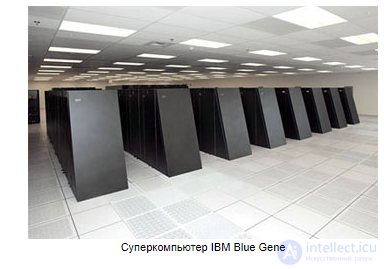Lecture
Crisis time
The nineties started for IBM pretty well. Despite the decline in the popularity of her personal computers, the company still made a big profit. The biggest in its history. It is a pity that this was only the results of the 80s. Later, the blue giant corny did not catch the main trends in the computer world, which led to not the most pleasant consequences.
Despite the success of personal computers, the penultimate decade of the last century, IBM continued to receive the majority of its revenue from mainframe sales. But the development of technology has allowed to switch to the use of more compact personal computers, and with them to large computers based on microprocessors. In addition, regulars were sold with lower margins than mainframes.
Now it’s enough to add the fall in sales of the main profitable product, the loss of its position in the personal computer market, and at the same time the failure in the network technology market, successfully employed by Novell, so as not to be surprised at the loss of $ 1 billion in 1990 and 1991 And 1992 turned out to set a new record - $ 8.1 billion loss. It was the largest corporate annual loss in US history.

Louis Gestner
Is it any wonder that the company began to "move"? In 1993, Louis V. Gerstner, Jr. began his presidency. His plan was to change the current situation, for which he radically restructured the company's policy, focusing the main divisions on providing services and developing software. IBM could certainly offer a lot of new things in the hardware field, but because of the multitude of computer manufacturers and the presence of other technology companies, it didn’t do that. Anyway, there is someone who offers a cheaper and no less functional product.
As a result, in the second half of the decade, IBM expanded its software portfolio with applications from Lotus, WebSphere, Tivoli, and Rational. Well, she also continued to develop her own DB2 relational database.
Thinkpad
Despite the crisis of the 90s, the blue giant presented one popular product. It was a line of notebooks ThinkPad, existing to this day, though already under the patronage of Lenovo. It was presented in the person of three models 700, 700C and 700T in October 1992. Mobile computers were equipped with a 10.4-inch screen, a 25 MHz Intel 80486SLC processor, a 120 MB hard disk, and a Windows 3.1 operating system. Their cost at the same time was $ 4350.
IBM ThinkPad 701

A little about the origin of the name of the series. The word "Think" was printed on leather-bound IBM corporate notebooks. One of the participants in the new generation mobile PC project proposed adding a "Pad" (keyboard, keypad) to it. At first, ThinkPad did not accept everything, citing the fact that until now the name of all IBM systems was numerical. However, in the end, the ThinkPad went as the official name of the series.
The body of the modern IBM (Lenovo) ThinkPad

The first ThinkPad notebooks have become very popular. Within a fairly short time, they collected more than 300 awards from various publications for high quality workmanship and multiple innovations in design. The latter include, in particular, the “butterfly keyboard”, which was slightly raised and stretched in width to make it easier to work. Later, with the increase in the diagonal of the screen of mobile computers, it was no longer necessary.

TrackPoint on an IBM ThinkPad Notebook
The TrackPoint was used for the first time - a new kind of manipulator. Today, it is still installed in ThinkPad laptops and many other enterprise-class mobile PCs. In some models, an LED was installed on the screen to illuminate the keyboard in the dark. IBM first integrated the accelerometer into the laptop, which determined the fall, after which the hard disk heads were parked, which greatly increased the likelihood of data being saved with a strong impact. ThinkPad was the first to use fingerprint scanners, as well as an integrated TPM module for data protection. Now all this to one degree or another is used by all laptop manufacturers. But we should not forget that IBM needs to thank for all these "delights of life".
While Apple paid a lot of money to Tom Cruise in the “Mission Impossible” saved the world with the help of the new PowerBook, IBM really moved the progress of humanity into a bright future with its ThinkPad notebooks. For example, the ThinkPad 750 flew in 1993 on the shuttle Endeavor. Then the main task of the mission was to repair the Hubble telescope. ThinkPad A31p for a long time used on the ISS.
Today, many traditions of IBM continues to support the Chinese company Lenovo. But this is the story of the next decade.
New Age
The change in the company's course in the current decade, which began in the mid-1990s, reached its apogee. IBM continued to focus on providing consulting services, creating new technologies for selling licenses to them, and developing software, while not forgetting about expensive equipment - the blue giant has not left this area so far.
The final stage of the reorganization took place between 2002 and 2004. In 2002, IBM acquired consulting firm PricewaterhouseCoopers, and at the same time sold its Hitachi hard drive division. Thus, the blue giant refused further production of hard drives, which he himself invented half a century earlier.
IBM Blue Gene supercomputer

IBM is not going to leave business of supercomputers and mainframes IBM. The company continues to fight for the top places in the Top500 rating and continues to do so with a fairly high success rate. In 2002, a special program with a budget of $ 10 billion was even launched, according to which IBM created the necessary technologies to be able to provide access to supercomputers of any company almost immediately after receipt of a request.
Lenovo logo
While the blue giant has big computers, everything is fine, but with little staffers, not everything went well. As a result, the year 2004 is marked as the year of the sale of computer business by IBM of the Chinese company Lenovo. The last went all the developments on personal systems, including the popular ThinkPad series. Lenovo even got the right to use the IBM brand for five years. IBM itself received in return $ 650 million in cash and $ 600 million in stock. Now she owns 19% of Lenovo. At the same time, the blue giant also continues to sell servers. Still not to continue, being in the first three of the largest players of this market.
So what was the result? In 2005, IBM employed about 195,000 employees, among which 350 were noted by the company as "outstanding engineers", and 60 people were honored with the title IBM Fellow. This title was introduced in 1962 by then-President Thomas Watsan to highlight the best company employees. Usually, IBM Fellow received no more than 4-5 people per year. Since 1963, there have been about 200 such employees in total. Of these, in May 2008, 70 people worked.
Possessing such a serious scientific potential, IBM has become one of the leaders in innovation. Between 1993 and 2005, the blue giant received 31,000 patents. At the same time, in 2003 he set a record for the number of patents obtained by one company in a year - 3,415 pieces.
In the end, today, IBM has become less accessible to the general consumer. In fact, the same thing happened before the 80s. For 20 years, the company has worked with retail products, but still returned to its roots, although in a slightly different incarnation. But still, its technology and development reach us in the form of devices from other manufacturers. So the blue giant stays with us further.

Comments
To leave a comment
History of computer technology and IT technology
Terms: History of computer technology and IT technology